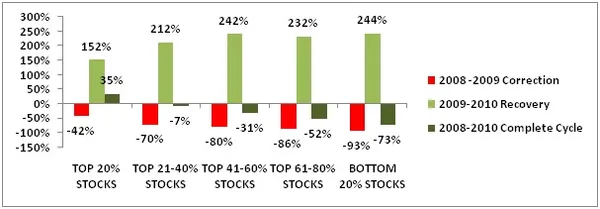Indian equity markets have seen two major corrections in the last 20 years excluding the ongoing crash of 2020. We have looked into the past stock market crashes and compared them with the ongoing crash. All of us are looking to find the answer for the following questions:-
1.Are we near the bottom?
2.Will my portfolio recover once markers start recovering after this crisis settles down?
3.Should I just sit tight on my existing investments or use current market conditions to restructure my portfolio and align it with current market conditions?
Lets us review the past stock market crashes and get some insights:-
Stock market crash of 2001 – Tech Bubble Burst
During 2000-2003 Nifty corrected almost 50% from its peak. This crash started with dot com burst followed by 9/11. Post 9/11 equity markets recovered 150% from its bottom to make a new high. This entire cycle of correction to recovery went on for 4 years wherein first 2 years markets corrected and then recovered. NIFTY corrected from a peak of 1750 in Jan 2000 to 850 in Sept 2001 and then attained a new high of 1950 in Dec 2003.
All the stocks reacted to the crash of the market where in some corrected much more than the NIFTY correction. We have divided stocks on NSE into 5 baskets based on their fall during correction phase. Set 1 is Top 20% which fell the least and Set 5 is bottom 20% stocks which fell the most. Then we have tried to look into what happened once recovery started. Did any particular set gained more than the rest or did everything recovered to pre-crisis level. Our findings are as below:-

Key takeaways:-
1. Almost all the stocks corrected during the correction phase wherein average correction in NSE universe was 58%.
2. During the recovery on an average all the stocks gained 3x from post crisis level and average recovery was 350%.
3. Top 40% stocks delivered more than 100% return during the entire cycle of correction and recovery while bottom 20% never came back from their original price.
Stock market crash of 2008 – Global Financial Crisis
During 2008-2009 Nifty corrected almost 60% from its peak and then recovered 150% from its bottom to come closer to previous high. This entire cycle of correction to recovery went on for 3 years wherein first 1.5 years markets corrected and next 1.5 years recovered; NIFTY corrected from a peak of 6300 in Jan 2008 to 2550 in March 2009 and then attained a high of 6300 in Dec 2010. All the stocks reacted to the crash of the market where in some corrected much more than the NIFTY correction.

Key takeaways:-
1. Average correction in NSE universe was much deeper at 73%. Even top 20% stocks corrected more than 40% while bottom 20% corrected more than 90%.
2. Average gains during the recovery phase were 220% and recovery was across the board.
3. Top 40% stocks delivered positive return during the entire cycle of correction and recovery while bottom 40% lost 50% of their value during this crisis.
Stock market crash of 2020 – Coronavirus
During 2020, Nifty corrected almost 40% from its peak; NIFTY corrected from a peak of 12400 in Jan 2020 to 7500 in March 2020. Broad market has been correcting from Jan 2018 and has already corrected almost 66% from its peak in Jan 2018.

If we compare the current fall to previous two big falls, it does look like that we may be near to the bottom although no one can call the top or bottom in the market. However the correction in all NSE stocks is almost similar to the previous two set ups. The bottom 20% stocks have lost almost 92% of initial value. Half of the NSE stocks have corrected more than 75% in the current fall.
I think the key question to answer is in which segment portfolio stocks reside currently.
1. If portfolio stocks are part of Top 20% or Top 40% stocks universe than over the next 1-2 years, your portfolio shall become net positive despite recent corrections.
2. If your portfolio stocks are part of Bottom 20% or Bottom 40% stocks of NSE universe than despite the recovery, the chances are that portfolio may not recover to its original value for a longer period
3. Restructuring the portfolio is absolutely necessary not only to preserve the further erosion in capital but also for the higher chances of gains during recovery phase.
In my next post, we will discuss about the sectors, which have become laggards from leaders, and the sectors showing early signs of leadership to lead during the recovery.

